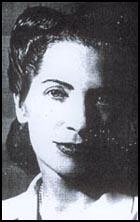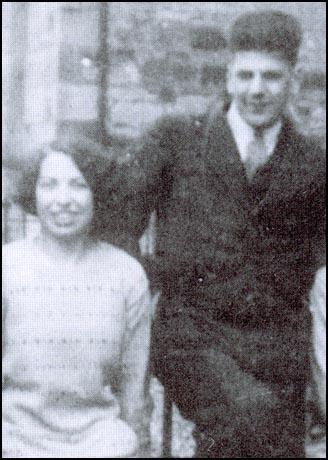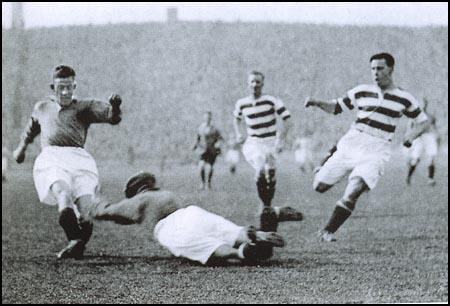Margaret Finlay

Margaret Finlay, the daughter of John Finlay, the under-manager of Wilson and Clyde Colleries, was born in Carluke, Lanark, on 4th August 1912. Finlay had married Chebolla Scott in 1906 and the couple had five children: William (1907), Jeannie (1909), Margaret (1912), Sybolla (1914) and Isabella (1916).
Margaret was educated at Edinburgh Ladies College. Her best subjects were mathematics and modern languages. She was also a talented dancer and was invited to join a touring troupe led by Anna Pavlova, the Russian ballerina, but her parents withheld their permission. After leaving college she joined the Inland Revenue.
In 1927 John Finlay was appointed as general manager of Edinburgh Collieries Company Limited. He was a keen supporter of Celtic and was invited to become a director of the club. However, he refused the position because he was a non-Catholic and was an active member of the Church of Christ (a Protestant evangelical church).
John Finlay took his children to Celtic home matches. In 1930 they were introduced to John Thomson, Celtic's international goalkeeper. John and Margaret were instantly attracted to each other and they soon developed a close relationship. Thomson became a regular visitor to the family home.
James Hanley, wrote in the The Story of the Celtic: 1888-1938 (1960) that: "It is hard for those who did not know him to appreciate the power of the spell he cast on all who watched him regularly in action. In like manner, a generation that did not see John Thomson has missed a touch of greatness in sport, for which he was a brilliant virtuoso, as Gigli was and Menuhin is. One artiste employs the voice as his instrument, another the violin or cello. For Thomson it was a handful of leather." The Celtic manager, Willie Maley, added: "His merit as a goalkeeper shone superbly in his play. Never was there a keeper who caught and held the fastest shots with such grace and ease. In all he did there was the balance and beauty of movement wonderful to watch."

In 1931 John Thomson got engaged to Margaret Finlay. A few weeks later, Celtic played Rangers in front of an 80,000 crowd at Ibrox Stadium in Glasgow. Early in the second half Sam English raced through the Celtic defence and looked certain to score, when Thomson dived at his feet. Thomson's head collided with English's knee which ruptured an artery in his right temple. One source (Celtic's Saddest Day) said "there were gasps in the main stand, a single piercing scream being heard from a horrified young woman." This was Margaret Finlay who was watching the game with Jim Thomson, John's brother.

After receiving treatment from the St Andrew's Ambulance Association he was taken from the field on a stretcher. According to The Scotsman, Thomson "was seen to rise on the stretcher and look towards the goal and the spot where the accident happened".
Thomson was taken to the Victoria Infirmary. He had sustained a lacerated wound over the right parietal bones of the skull. This caused a depression of the skull, two inches in diameter. At 5 pm Thomson suffered a major convulsion. Dr. Norman Davidson carried out an emergency operation in an attempt to relieve the pressure caused by swelling in the injured brain. The operation was unsuccessful and John Thomson died at 9.25 that evening. He was 22 years old.
An estimated 30,000 people attended the funeral in Cardenden on Wednesday, 9th September, 1931. This including thousands who had travelled through from Glasgow, many walking the 55 miles to the Fife village. An estimated 20,000 turned out at Glasgow's Queen Street station in order to watch two trains set off with two thousand passengers who could afford to pay the four shillings return fare.
In 1932 Margaret Finlay decided to work at the Inland Revenue's main office in London. It was here she met James Callaghan, who was later to become Britain's Prime Minister.
On the outbreak of the Second World War Finlay attempted to join the Women's Auxiliary Air Force. However, as a senior tax inspector, she was considered to be too valuable to the Inland Revenue. In 1943 she was sent to Cairo in Egypt as an Assistant Principle in the Treasury. Soon afterwards Finlay was recruited to join the highly secret Special Operations Executive.
While working in Egypt Margaret Finlay met Charles Patrick Straker of the Queen's Royal Regiment. The couple married on 7th December 1945. The following year they returned to London. Margaret's only child, Sybolla Straker, was born on 6th November 1946.
Charles Straker was a career army officer and over the next few years he was based in Germany, Singapore and Kenya before retiring to Toronto, Canada.
Margaret Finlay Straker died of a heart attack at Trafalgar Hospital, Oakville, Ontario, on 16th March, 1980.
Primary Sources
(1) Tom Greig, My Search for Celtic's John (2003)
John Finlay was a typical Scottish lad o' pairts, a much-gifted young man committed from an early age to improving his lot in life. He was born in Law in Lanarkshire in 1886, at the height of the industrial age which had made Britain great, and completed his basic education at Law Public School. Just twelve years old, he began his working life as a pit boy at Shawfield Colliery. Amply endowed with the Victorian qualities of ambition, independence of mind and a determination to succeed, he was quick to appreciate the advantages of further education. He loved to quote Sir James Murray's dictum, "Knowledge is power", and he did so throughout his life to anyone who would listen. The young Finlay attended classes at Coatbridge Technical School and Mining College with such success that he won every prize on offer, including the Ross medal for the best student. He gained further distinction as the King Edward medallist in mining and was awarded First Class Honours in the Board of Education examinations, South Kensington. He began to combine the back-breaking toil of the miner and ganger by day with pursuit of part-time studies in his leisure hours. Bill, his young son, was often sent by his mother to meet his father at the colliery gates with a Scottish "piece", a filled sandwich or two which enabled him to proceed directly to night-school courses without going home for a meal. Such was the determination of the man.
Further study at the Royal Technical College, Glasgow, and the acquisition of a First Class Certificate of Competency in Mine Management, quickly led to appointments as under-manager then manager at Messrs Wilson and Clyde Coal Company's Law Collieries and later at the Coltness Iron Company's Kingshill No 3 pit. After a period as general manager with the Edinburgh Collieries Company Limited, he left in 1927 to take up a similar appointment with United Collieries Limited. The subsequent appointment as managing director of this company in 1939 placed John Finlay in direct control of 14 collieries and 2,500 employees. He had studied coal-mining in Germany for a year and his deep knowledge and wide experience of the industry had brought him deserved recognition in his chosen career. In his early days he was called upon to share his expertise with fellow miners through a lectureship in mining at his old college in Coatbridge. Towards the end of his life, his achievements were capped with the Presidency of the Mining Institute of Scotland, which he held from 1942 to 1945. This was a time when World War II was finely poised. A coalition government, hampered by falling levels of coal production and threats of recurring strikes, was gearing up for a final push in Europe. The importance of coal to the war effort, and Finlay's personal devotion to his weighty responsibilities in helping to deliver it, undoubtedly contributed to his premature death at the age of 60 on March 26'h 1946. Today, such a man would be hailed as a captain of industry and be a strong candidate for a knighthood.
(2) Nick Hazlewood, In the Way! Goalkeepers: A Breed Apart? (1996)
More than 80,000 were at Ibrox to witness an event that has remained imprinted on the Scottish football psyche ever since. With the second half barely five minutes old, Rangers striker Sam English broke free and lined up to shoot from near the penalty spot. He seemed certain to score, when Thomson launched one of his do-or-die head-first saves at the attacker's feet. It was Thomson's trademark save - in February 1930 against Airdrie he'd been injured doing exactly the same thing, fracturing his jaw and injuring his ribs. This time there was an even more sickening crunch, Thomson's head colliding with English's knee at the moment of greatest impact. It was no longer a do-or-die moment, it was a do-and-die. The ball ran out of play, English fell to the ground and rose limping, Thomson lay unconscious, blood seeping into the pitch.
The dazed English was the first to realise the seriousness of the blow and hobbled over to the unmoving keeper, waving urgently for assistance. Celtic fans were cheering the missed goal, Rangers fans were taunting the injured keeper, but the gravity of the situation was soon upon them. Rangers' captain Davie Meiklejohn raised his arms to implore the home fans to be silent. A hush descended over the ground. In the stands Margaret Finlay, Thomson's fiancee, broke down as she saw him borne from the ground, head wrapped in bandages, body limp...
What followed was an outpouring of public grief that, it is said, briefly united communities across the sectarian divide. In Bridgeton, Glasgow, traffic was brought to a halt by thousands of pedestrians walking past a floral tribute to Thomson, placed in a shop window by the local Rangers supporters club. And at Glasgow's Trinity Congregational Church there were unruly scenes when thousands struggled to get into Thomson's memorial service. Women screamed with alarm at the crush and only swift action by police cleared a passageway and stemmed the rush. Celtic right-half Peter Wilson, who was due to read a lesson, failed to gain entrance and found himself stranded outside the church for the ceremony.
Tens of thousands went to Queen Street station to see the coffin off on its train journey home to Fife. Many thousands more made the same journey: by train, by car and by foot. Unemployed workers walked the 55 miles, spending the night on the Craigs, a group of hills behind Auchterderran. In Fife, local pits closed down for the day and it seemed as if the whole of Scotland had swelled the small streets of Cardenden. Thomson's coffin, topped by one of his international caps and a wreath in the design of an empty goal, was carried by six Celtic players the mile from his home to Bowhill cemetery, where he was laid to rest in the sad and quiet graveyard populated by the victims of many, many mining disasters.
(3) Tom Greig, My Search for Celtic's John (2003)
A Celtic attack had broken down. Davie Meiklejohn, the Rangers captain and right half, emerged with the ball and saw possibilities for an attack down Celtic's left flank, along the grandstand touchline. His measured pass was picked up by his team mate, the fleet-footed Jimmy Fleming, who was alert and quick enough to elude a challenging tackle from Celtic's left back Peter McGonagle. Looking up, Fleming immediately noted that the failed Celtic attack had caught their centre half Jimmy McStay upfield, and struggling to get back into the heart of his defence. He saw too that, unmarked, Rangers' young centre forward, Sam English, had stolen through the inside right channel into a dangerous position at the edge of Celtic's eighteen-yard box. The pass, which Fleming dispatched in front of the on-rushing English, was an inch-perfect invitation to shoot for goal, and English gave it his very best.
From the moment he had seen his team's forward momentum falter, Thomson was primed for danger. He could see that his captain McStay would not make it back in time. He tensed as the thrusting counter-attack developed with such speed in front of him. He had watched McGonagle's tackle on Fleming fail. Now English was rapidly bearing down on him. No other defender was close enough to intervene. All his senses told the keeper that English was going to shoot. In the few seconds that remained to him to make a decision, Thomson was torn between two of his most basic goalkeeping instincts formed long before on the far-off fields of his native Fife: not to leave his line, unless in extremis; but always to go for the ball. He moved towards English, crouching and creeping forward to narrow the angle. Fractionally he hesitated on the six yard line, winding himself up to pounce. All the options to save his goal had now come down to his own judgment and personal courage. With eyes never leaving the ball, he launched himself towards his opponent's feet. As a contemporary photograph clearly shows, English's boot had already connected cleanly with the ball sending it goalwards before Thomson's brave and selfless dive had diverted it off his projectile body to trickle safely past his right hand post. The fact that the referee awarded a goal kick notwithstanding, Celtic's last line of defence had executed one of his bravest saves and once more had not been found wanting when crisis threatened his team.
